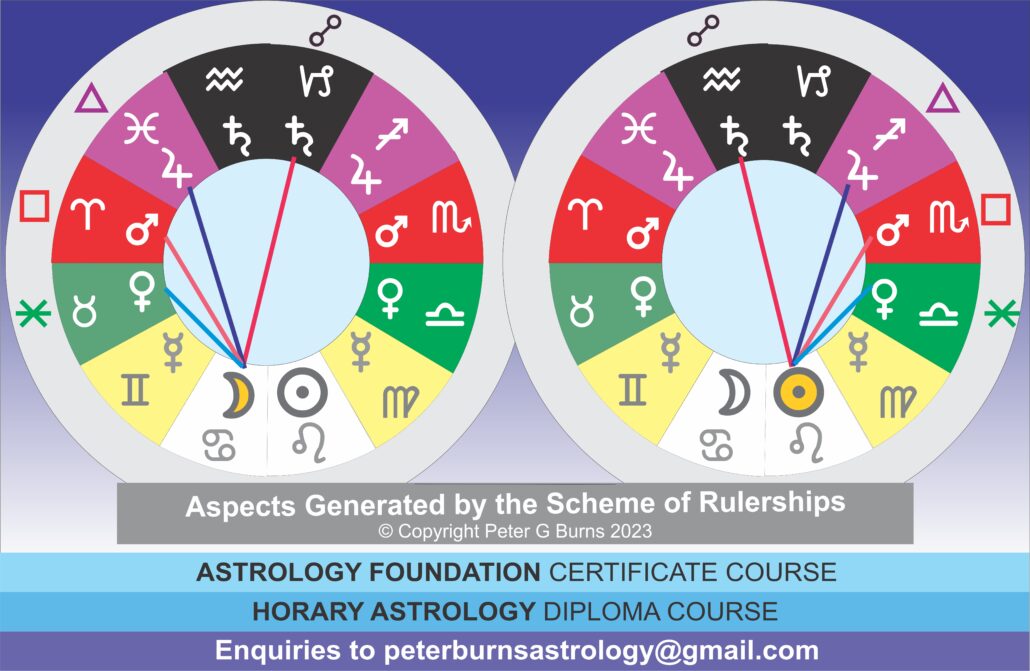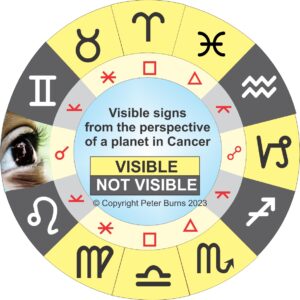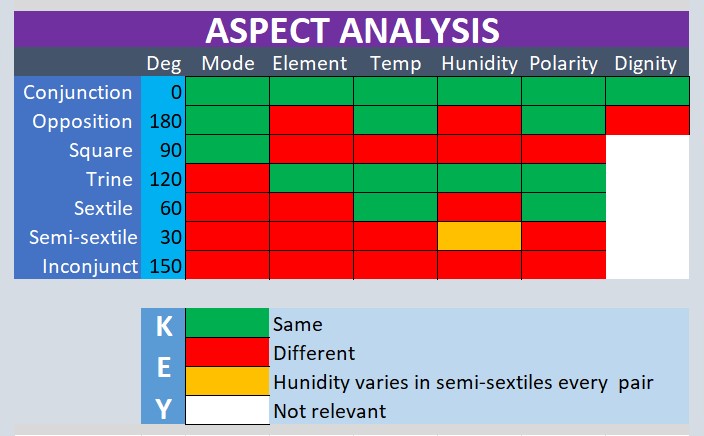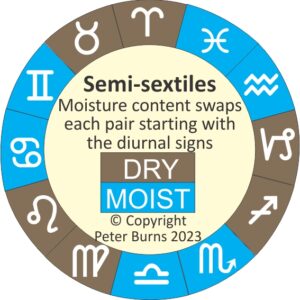The glorious Sun
 In my October 16 post I spoke about how the Sun allocates the rulerships of the Moon and planets. This allocation determines aspect meanings according to which planets are linked with the lights.
In my October 16 post I spoke about how the Sun allocates the rulerships of the Moon and planets. This allocation determines aspect meanings according to which planets are linked with the lights.
- Sextile aspects are associated with Venus, the planet of relaxation and pleasure.
- Squares are associated with Mars, the planet of friction quarrels and violence.
- Trines are associated with Jupiter, the planet of prosperity, compassion, and good times.
- Oppositions are associated with Saturn, the planet of darkness, coldness, privation, and rejection.
The difference between sextiles and trines
In my October 21 post I compared the difference between the trine and sextile aspects. Examining the primary qualities which compose the elements I concluded that trine aspects links signs with the same temperature and humidity, and the sextile aspect links signs of the same temperature but a different humidity.
The trine links signs with twice the number of primary qualities as the sextile. Both aspects link signs of the same polarity. Therefore, the trine is stronger than the sextile.
What about semi-sextiles and inconjuncts?
Several people asked about semi-sextiles and inconjuncts. How do they fit into this picture? Before that question can be answered there is the issue of whether semi-sextiles and inconjuncts are really aspects. The word aspect means to see or behold.
Traditional astrology holds that semi-sextiles and inconjuncts are not visible and therefore are not aspects in the true sense. According to this view planets cannot see other planets which are in adjacent signs or in signs adjacent the opposing sign.
 Aspects and visibility
Aspects and visibility
The diagram titled Visible signs from the perspective of a planet in Cancer shows signs which are visible and not visible. Included are the aspects from the viewer’s perspective.
From the viewing planet’s perspective in Cancer the visible signs are those in sextile: Taurus and Virgo: those in square: Aries and Libra: those in trine: Pisces and Scorpio; and Capricorn, which is in opposition. However planets which are semi-sextile in Gemini and Leo, and planets which are inconjunct in Aquarius and Sagittarius, are not visible.
If a different sign was rising, for example Aries, then the same aspects would apply, with planets in Pisces and Taurus being semi-sextile and Virgo and Scorpio inconjunct.
Drilling down
 The Aspect Analysis diagram shows the five primary aspects. Although the conjunction is not technically an aspect it is included.
The Aspect Analysis diagram shows the five primary aspects. Although the conjunction is not technically an aspect it is included.
Planets in conjunction have identical characteristics. Notice the row of green showing identical characteristics of Mode, Element, Temperature, Humidity, Polarity and Dignity.
The column titled Dignity refers to rulership and exile (detriment). For example, 2 planets in conjunction in Virgo will both be ruled by Mercury and are both in a sign where Jupiter is in exile.
The opposition
The opposition is interesting as it links planets in the same mode, temperature, and polarity, but not in the same element, with humidity being the difference. The reason why the opposition is considered the most challenging aspect is that it links planets with opposite rulerships. Using the analogy of planets as people, the opposition suggests that each planet honours what the other rejects.
Example: Consider a planet in Virgo opposite a planet in Pisces. The Virgo planet honours Mercury and rejects Jupiter. While the Pisces planet honours Jupiter and rejects Mercury.
Even though the only commonality with planets in square aspect is that they share the same mode, the opposing dignities show that the opposition aspect is more challenging.
Trines and sextiles
Unsurprisingly the trine aspect links planets with the most in common, aside from the conjunction. The sextile links planets in different elements, with the humidity component making the difference.
Semi-sextiles and the inconjuncts
 The rows of red in the Aspect Analysis diagram show that planets in semi-sextile and inconjunct relationships have nothing in common. A minor detail is that humidity varies from same to different with every pair of semi-sextiles. This minor detail does little to elevate the status of the semi-sextile.
The rows of red in the Aspect Analysis diagram show that planets in semi-sextile and inconjunct relationships have nothing in common. A minor detail is that humidity varies from same to different with every pair of semi-sextiles. This minor detail does little to elevate the status of the semi-sextile.
If planets in semi-sextile and inconjunct relationships are considered to be in aspect (not my choice), then, according to this analysis, they are the worst possible aspect. Planets in these relationships have nothing to share or benefit from each other. They are like aliens who do not meet.
My own experience is that the horoscope is better understood when there is more focus on the standard, so-called Ptolemaic aspects, especially in the early years of astrological study.
Going deeper with the basics adds precision and clarity. Adding more when there is less understanding of the basics has little benefit and tends to clutter the mind.